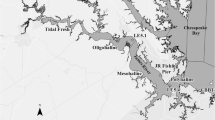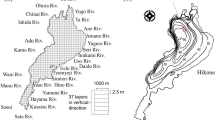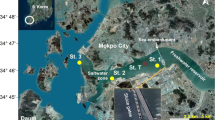Abstract
Many coastal ecosystems are undergoing anthropogenic stress from large increases in population and urbanization. In many regions changes in freshwater and material inputs to the coastal zone are altering the biogeochemical and biological capacities of ecosystems. Despite increased watershed inputs, large tidal volumes and flushing indicative of macrotidal estuaries can modulate the fate of introduced materials masking some of the symptoms of eutrophication. The Land Use Coastal Ecosystem Study (LU-CES) examined linkages between land use and environmental properties of Malind and Okatee Creeks in South Carolina from 2001 to 2004. The objectives of this particular study were to assess the hydrography of the two macrotidal creek ecosystems, explore differences in dissolved oxygen (DO), and develop a better understanding of the variations in primary and benthic secondary production in southeastern creek ecosystems. Depth, pH, salinity, and DO were reduced and more variable in Malind Creek than in Okatee Creek, although both creeks had strong semidiurnal frequencies in salinity time signatures. While time series analyses of DO saturation in Malind Creek revealed a dominant semidiurnal pattern, Okatee Creek had a distinctly diel DO pattern. The strongly semidiurnal fluctuations in DO and reduced flushing time indicated that biological processes were not fast enough to influence DO in Malind Creek. The Okatee Creek system had a much greater storage volume, a wider marsh, and a dominant 25-h DO frequency. These attributes contributed to an estimated 8–10 times more phytoplankton-based carbon in Okatee Creek and twice the annual benthic production. As expected from their proximity to the upland, low surface area, and high organic content, both ecosystems were net heterotrophic. This fundamental understanding of tidal creek hydrography is being used to help define linkages among differential watershed land uses, flushing characteristics, and levels of biological production in coastal ecosystems of the southeastern United States.
Similar content being viewed by others
Literature Cited
Aikman, F. and L. W. J. Lanerolle. 2005. Report on the NOS workshop on residence/flushing times in bays and estuaries. NOAA Technical Report NOS CS 20. Silver Spring, Maryland.
Beach, D.. 2002. Coastal Sprawl: The Effects of Urban Design on Aquatic Ecosystems in the United States. Pew Oceans Commission. Arlington, Virginia.
Bowen, J. L. andI. Valiela. 2004. Nitrogen loads to estuaries: Using loading models to asses the effectiveness of management options to restore estuarine water quality.Estuaries 27:482–500.
Bricker, S. B., C. G. Clement, D. E. Pirhalla, S. P. Orlando, andD. R. G. Farrow. 1999. National Estuarine Eutrophication Assessment: Effects of Nutrient Enrichment in the Nation’s Estuaries. National Centers for Coastal Ocean Science, National Oceanic and Atmospheric Administration. Silver Spring, Maryland.
Buzzelli, C. P., O. Akman, T. Buck, E. Koepfler, J. Morris, andA. Lewttus 2004. Relationships among water quality parameters from the North Inlet-Winvah Bay National Estuarine Research Reserve, South Carolina.Journal of Coastal Research SI 45:59–74.
Buzzelli, C. P., R. A. Luettich, S. P. Powers, C. H. Peterson, J. E. McNinch, J. L. Pinckney, andH. W. Paerl. 2002. Estimating the spatial extent of bottom-water hypoxia and habitat degradation in a shallow estuary.Marine Ecology Progress Series 230:103–112.
Buzzelli, C. P., R. L. Wetzel, andM. B. Meyers. 1999. A linked physical and biological framework to assess biogeochemical dynamics in a shallow estuarine ecosystem.Estuarine Coastal and Shelf Science 49:829–851.
Caffrey, J. M.. 2004. Factors controlling net ecosystem metabolism in U.S. estuaries.Estuaries 27:90–101.
Childers, D. L., H. N. McKellar, R. F. Dame, F. H. Sklar, andE. R. Blood. 1993. A dynamic nutrient budget of subsystem interactions in a salt marsh estuary.Estuarine Goastal and Shelf Science 36:105–131.
Cloern, J. C.. 2001. Our evolving conceptual model of the coastal eutrophication problem.Marine Ecology Progress Serries 210:223–253.
Cooney, T. W., P. A. Drewes, S. W. Ellisor, T. H. Lanier, and F. Melendez. 2005. Water Resources Data South Carolina Water Year 2004. U.S. Geological Survey, Water-Data Report SC-04-1. Columbia, South Carolina.
Crossett, K. M., T. J. Culliton, P. C. Willey, and T. R. Goodspeed. 2004. Population Trends along the Coastal United States: 1980–2008. National Oceanic and Atmospheric Administration Coastal Trends Report Series. Silver Spring, Maryland
Dame, R., M. Alber, D. Allen, M. Mallin, C. Montague, A. Lewitus, A. Chalmers, R. Gardner, C. Gilman, B. Kjerve, J. Pinckney, andN. Smith. 2000. Estuaries of the south Atlantic coast of North America: Their geographical signatures.Estuaries 23:793–819.
Dame, R. F., D. L. Childers, andE. T. Koepfler. 1992. A geohydrologic continuum theory for the spatial and temporal evolution of marsh-estuarine ecosystems.Netherlands Journal of Sea Research 30:63–72.
de Groot, R. S., M. A. Wilson, andR. M. J. Boumans. 2002. A typology for the classification, description, and valuation of ecosystem functions, goods, and services.Ecological Economics 41:393–408.
Dettmann, E. H.. 2001. Effect of water residence time on annual export and denitrification of nitrogen in estuaries: A model analysis.Estuaries 24:481–490.
Edwards, D., D. Hurley, andE. Wenner. 2004. Nonparametric harmonic analysis of estuarine water quality data: A National Estuarine Research Reserve case study.Journal of Coastal Research SI 45:75–92.
Eiser, W. C. andB. Kjerfve. 1986. Marsh topography and hypsometric characteristics of a South Carolina salt marsh basin.Estuarine Coastal and Shelf Science 23:595–605.
Fagherazzi, S. andD. J. Furbish. 2001. On the shape and widening of salt marsh creeks.Journal of Geophysical Research 106:991–1003.
Friedrichs, C. T. andD. G. Aubrey. 1994. Uniform bottom shear stress and equilibrium hypsometry of inter-tidal flats, p. 1–27.In C. Pattiaratchi (ed.), Mixing Processes in Estuaries and Coastal Seas. American Geophysical Union, Washington, D.C.
Gardner, L. R.. 2005. A modeling study of the dynamics of pore water seepage from inter-tidal marsh sediments.Estuarine Coastal and Shelf Science 62:691–698.
Gardner, L. R. andD. E. Porter. 2001. Stratigraphy and geologic history of a southeastern salt marsh basin, North Inlet, South Carolina, USA.Wetlands Ecology and Management 9:371–385.
Gillett, D. J., A. F. Holland, andD. M. Sanger. 2005. Secondary production of a dominant oligochaete (Monopylephorus rubroniveus) in the tidal creeks of South Carolina and its relation to ecosystem characteristics.Limnology and Oceanography 50:566–577.
Holland, A. F., D. M. Sanger, C. P. Gawle, S. B. Lerberg, M. S. Santiago, G. H. M. Riekerk, L. E. Zimmerman, andG. I. Scott. 2004. Linkages between tidal creek ecosystems and the landscape and demographic attributes of their watersheds.Journal of Experimental Marine Biology and Ecology 298:151–178.
Hopkinson, C. S. andJ. J. Vallino. 1995. The relationships among man’s activities in watersheds and estuaries: A model of runoff effects on patterns of estuarine community metabolism.Estuaries 18:598–621.
Imberger, I., T. Berman, R. R. Christian, E. B. Sherr, D. E. Whitney, L. R. Pomeroy, R. G. Wiegert, andW. J. Wiebe. 1983. The influence of water motion on the distribution and transport of materials in a salt marsh estuary.Limnology and Oceanography 28:201–214.
Kneib, R. T.. 2003. Bioenergetic and landscape considerations for scaling expectations of nekton production from inter-tidal marshes.Marine Ecology Progress Series 264:279–296.
Lerberg, S. B., A. F. Holland, andD. M. Sanger. 2000. Responses of tidal creek marcrobenthic communities to the effects of watershed development.Estuaries 23:838–853.
Luketina, D.. 1998. Simple tidal prism models revisited.Estuarine Coastal and Shelf Science 46:77–84.
Mallin, M. A., S. H., Ensign, M. R. McIver, G. C. Shank, andP. K. Fowler. 2001. Demographic, landscape, and meteorological factors controlling the microbial pollution of coastal waters.Hydrobiologia 460:185–193.
Monbet, Y. 1992. Control of phytoplankton biomass in estuaries: A comparative analysis of microtidal and macrotidal estuaries.Estuaries 15:563–571.
Monsen, N. E., J. E. Cloern, L. V. Lucas, andS. G. Monismith. 2002. A comment on the use of flushing time, residence time, and age as transport time scales.Limnology and Oceanography 47:1545–1553.
Morris, J. T., P. V. Sundareshwar, C. T. Nietch, B. Kjerfve, andD. R. Cahoon. 2002. Responses of coastal wetlands to rising sea levels.Ecology 83:2869–2877.
Mwamba, M. J., andR. Torres. 2002. Rainfall effects on marsh sediment redistribution, North Inlet, South Carolina, USA.Marine Geology 189:267–287.
Nixon, S. W.. 1995. Constal marine eutrophication: A definition, social causes, and future concerns.Ophelia 41:199–219.
Nixon, S. W., J. W., Ammerman, L. P. Atkinson, V. M. Berounsky, G. Billen, W. C. Boicourt, W. R. Boynton, T. M. Church, D. M. Ditoro, D. M. R. Elmgren, J. H. Garber, A. E. Giblin, R. A. Jahnke, N. J. P. Owens, M. E. Q. Pilson, andS. P. Seitzinger. 1996. The fate of nitrogen and phosphorus at the land-sea margin of the North Atlantic Ocean.Biogeochemistry 35:141–180.
Odum, E. P.. 1980. The status of three ecosystem-level hypotheses regarding salt marsh estuaries: Tidal subsidy, outwelling, and detritus-based food chains, p. 485–495.In V. S. Kennedy (ed.), Estuarine Perspectives. Academic Press, Inc., New York.
Odum, H. T., W. M. Kemp, M. Sell, W. R. Boynton andM. Lehman, 1977. Energy analysis and the coupling of man and estuaries.Environmental Management 1:297–315.
Odum, W. E., E. P. Odum, andH. T. Odum. 1995. Nature’s pulsing paradigm.Estuaries 18:547–555.
Pomeroy, L. R. andR. G. Wiegert (eds.). 1981. The Ecology of a Salt Marsh. Springer-Verlag, New York.
Posey, M. H., T. D. Alphin, L. B. Cahoon, D. G. Lindquist, M. A. Mallin, andM. B. Nevers. 2002. Top-down versus bottom-up limitation in benthic infaunal communities: Direct and indirect effects.Estuaries 25:999–1014.
Reynolds-Fleming, J. V. andR. A. Luettich, Jr. 2004. Win-driven lateral variability in the upper Neuse River Estuary.Estuarine Coastal and Shelf Science 60:395–407.
Sanger, D. M., M. D. Arendt, Y. Chen, E. L. Wenner, A. F. Holland, D. Edwards, and J. Caffrey. 2002. A synthesis of water quality data: National Estuarine Research Reserve System-wide Monitoring Progam (1995–2000). National Estuarine Research Reserve Technical Report Series 2002:3, South Carolina Department of Natural Resources, Marine Resources Division Contribution No. 500, Charleston, South Carolina.
Sanger, D. M., A. F. Holland, andG. I. Scott. 1999a. Tidal creek and salt marsh sediments in South Carolina coastal estuaries: 1. Distribution of trace metals.Archives of Environmental Contamination and Toxicology 37:445–457.
Sanger, D. M., A. F. Holland, andG. I. Scott. 1999b. Tidal creek and salt marsh sediments in South Carolina coastal estuaries: II. Distribution of organic contaminants.Archives of Environmental Contamination and Toxicology 37:458–471.
South Carolina Sea Grant Consortium. 2005. The Land Use Coastal Ecosystem Study (LU-CES) annual progress report, 2003–2004. South Carolina Sea Grant Consortium. Charleston, South Carolina.
Systat. 2004. SYSTAT 11 Statistic I–III. SYSTAT software, Richomond, California.
Vallino, J. J. andC. S. Hopkinson. 1998. Estimation of dispersion and characteristic mixing times in Plum Island Sound Estuary.Estuarine Coastal and Shelf Science 46:333–350.
Verity, P. G.. 2002. A decade of change in the Skidaway River Estuary. I. Hydrography and nutrients.Estuaries 25:944–960.
Vorosmarty, C. J. andT. C. Loder. 1994. Spring-neap tidal contrasts and nutrient dynamics in a marsh-dominated estuary.Estuaries 17:537–551.
Ward, L. G.. 2004. Variations in physical properties and water quality in the Webhannet River Estuary (Wells National Estuarine Research Reserve, Maine).Journal of Coastal Research 45:39–58.
Wenner, E. L. andM. Geist. 2001. The National Estuarine Research Reserves program to monitor and preserve estuarine waters.Coastal Management 29:1–17.
Wenner, E. L., D. Sanger, M. Arendt, A. F. Holland, andY. Chen. 2004. Variability in dissolved oxygen and other water quality variables within the National Estuarine Research Reserve system.Journal of Coastal Research 45:17–38.
Whiting, G. J. andD. L. Childers. 1989. Subtidal advective water flux as a potentially important nutrient input to southeastern U.S.A. salt marsh estuaries.Estuarine Coastal and Shelf Science 28:417–431.
Zheng, L., C. Chen, andH. Liu. 2003. A modeling study of the Satilla River Estuary, Georgia. I: Flooding-drying process and water exchange over the salt marsh-estuary-shelf complex.Estuaries 26:651–669.
Sources of Unpublished Materials
Allen, J. andK. S. Lu. 2000. Modeling and predicting future urban growth in the Charleston area. Strom Thurmond Institute, Clemson University, Clemson, South Carolina. September 2001. (http://www.charleston.net/org/greenbelt/method.html.)
Blanton, J. O. unpublished data. Skidaway Institute of Oceanography. 10 Ocean Science Circle, Savannah, Geogria 31411.
McKellar, H. N. unpublished data. South Carolina Department of Natural Resources, Freshwater Fisheries Research Laboratory, 1921 VanBoklen Road, Eastover, South Carlina 29044.
Author information
Authors and Affiliations
Corresponding author
Rights and permissions
About this article
Cite this article
Buzzelli, C., Holland, A.F., Sanger, D.M. et al. Hydrographic characterization of two tidal creeks with implications for watershed land use, flushing times, and benthic production. Estuaries and Coasts: JERF 30, 321–330 (2007). https://doi.org/10.1007/BF02700174
Received:
Revised:
Accepted:
Issue Date:
DOI: https://doi.org/10.1007/BF02700174




